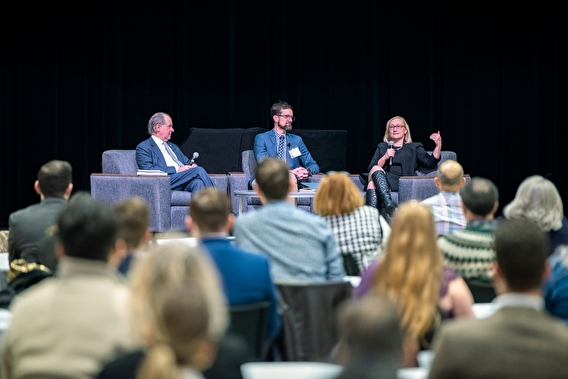
Transportation agencies need a completely new framework for planning and building projects—one that incorporates community feedback throughout the entire process, said Lynn Peterson, opening keynote at the 2023 CTS Transportation Research Conference.
“We need to rethink how we build trust,” Peterson said.
Peterson, president of the Portland, Oregon, Metropolitan Council, said that transportation planning has traditionally followed a top-down approach. Construction projects are proposed, sometimes for political reasons, and community-level input is sought after the fact. Often, this leads to public pushback, canceled projects, “overbuilt” and overly expensive infrastructure, and racial inequities born from the racial biases baked into the system.
When Peterson worked for the Wisconsin Department of Transportation, for example, she was involved with a road project that aimed to expand Highway 12 near Madison into a four-lane highway. Local farmers were outraged, Peterson said, because the proposal would eat up farm land, increase traffic speeds, and promote sprawl along the corridor.
“Nobody talked to the farmers in this community,” Peterson said. “Nobody talked about the future of the region and where [they] wanted growth. We just went out and said, ‘This is better’ without talking to anyone.”
Communities of color are also often ignored in the transportation planning process, Peterson said. Albina, Oregon—a primarily Black district of Portland—was significantly damaged by the construction of Interstate 5 in the 1950s. Similarly, the construction of Interstate 94 through the Rondo Community in St. Paul, Minnesota, destroyed 700 Black-owned homes and 300 Black-owned businesses.
The solution to these problems, Peterson said, is to start the planning process at the community level. Rather than starting with a project idea, she recommends going out into the field and talking with local leaders—people in charge of local-level religious organizations, tribes, businesses, environmental advocacy groups, cultural organizations, and other stakeholders.
From this input, the goal is to create a guiding problem statement that reflects the values of the community. This should not be a short or linear process, Peterson emphasized, but rather a “learning loop” with multiple iterations; the goal is to integrate as many perspectives as possible. Agencies need people who can facilitate tense public conversations, translate “engineer-speak” into plain language, and build trust in government, she said.
A recent book by Peterson—Roadways for People—includes these examples and other case studies.

Following her presentation, Peterson and Charles Zelle, chair of the Twin Cities Metropolitan Council, answered questions about how Peterson’s community-oriented planning structure could be applied locally.
“This is a human enterprise,” Zelle said, “and transportation is all about community.”
Zelle said that community-based planning can be difficult—especially with big, expensive projects that involve decades of planning and many affected people desiring input.
The Blue Line light-rail extension in Minneapolis, for example, has faced delays and backlash because of public concern that the project will displace residents and businesses from communities of color.
“Sometimes those values get hazy in the quest to do the project,” Zelle said.
Ultimately, though, Zelle said that collecting community input is a better, less risky move in the long term. Prioritizing solid planning over speed reduces risk that the project will need to be fixed, litigated, or canceled entirely.
In the case of the Blue Line extension, the Met Council and Hennepin County launched an initiative with the University of Minnesota’s Center for Urban and Regional Affairs to study possible displacement effects on current residents and businesses. The initiative’s working group developed anti-displacement policies and strategy recommendations and published them in a final report and executive summary.
“Lifestyle and economic impacts are part of our mission,” Zelle said, “even if not part of our traditional role. It’s a value-driven process. We’ve learned, and we’re doing it differently.”
Moving forward, the Met Council is working on its 2050 regional development plan. Public hearings will allow community input to the plan, slated for adoption by the end of 2024. “That vision needs to be widely held and percolate from real-life experience,” Zelle said.
Peterson agreed: “If you do not have those relationships and you have not been listening to people and you have not totally integrated their lived experiences into your thought process, you’re starting from a basic level of distrust.”
The conference was held November 2 on the University of Minnesota Twin Cities campus.
—Sophie Koch, contributing writer


